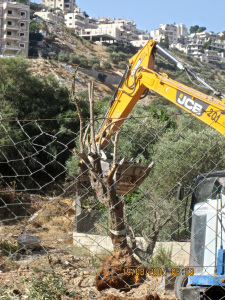Holy Land: How the Separation Barrier came to the Cremisan Valley

Bulldozers destroy ancient olice grove
The 2nd of April 2015 seemed like a good day for Palestinians and for Christians in the Holy Land after a two-year court battle reached a resolution. The Israeli Supreme Court ordered the defence ministry to reconsider the route of the Barrier. This ruling halted the Israeli militaries plans to take 75% of a convent's land in the Cremisan Valley, surround it on three sides by a 12 meter high separation barrier, divide it from the neighbouring monastery, deprive 58 Palestinian Christians of their land and prevent over 400 families from accessing their land without a permit.
Media around the world were quick to highlight this rare victory in a case that had been supported by Churches around the world and in which the Pope had taken a close interest.
But the Separation Barrier was still built. The photographs in the article on this link chart how it happened. See: https://blog.eappi.org/2016/04/26/a-timeline-how-the-separation-barrier-came-to-the-cremisan-valley/
On the 6th of July 2015, the Israeli Supreme Court rules that its previous decision would only apply to the land surrounding the monastery and convent and not to lands privately owned by the people of Beit Jala. This gives the Israeli authorities the green light to confiscate Palestinian land and resume construction on the Barrier through the Cremisan Valley. During August and September 2015 landowners hold regular peaceful protests and local churches hold regular services on the site to draw attention to how their land is being seized.
On the 17th of August 2015 the Israeli military arrives without warning to uproot the 1,000 year old olive trees, paving the way for the barrier's construction.
A Methodist minister present at an open air Mass next to the olive grove, describes how the prayers continued despite the destruction: "Normally when we say the Lord's prayer together in English and Arabic, those saying it in English finish first. But on this day as we prayed while bulldozers uprooted olives trees that were older than the time of Christ, no one was able to finish the words of the prayer we were so overcome with sadness."
During August 2015, demonstrations which were intended to be nonviolent, turn violent. After teargas is used on children and peaceful demonstrators, the affected landowners decide that they can no longer put their families through this and cease the regular protests and church services. Without this focus point, interest from supporters around the world begins to wane.
On the 16th of December 2015 a plan is approved to construct 891 new residential units in the nearby Israeli settlement of Gilo. This increases the locals concerns that the route of the Barrier through the Cemisan Valley was designed to bring Har Gilo settlement to the Israeli side of the Barrier and connect it to Gilo settlement in East Jerusalem. According to the Israeli human rights group B'Tselem: "The Cremisan Valley [...] will apparently be turned into a free public space for the residents of Gilo and Har Gilo. This belies the security justifications for the route of the barrier accepted by the High Court of Justice, according to which an empty buffer zone is needed in order to protect Israeli citizens."
Following a legal appeal by the affected communities, on the 30th of January 2016 an Israeli court rules that construction can continue for security reasons. The International Court of Justice's 2004 Advisory Opinion specifically confirmed that such a route as this, which goes 3 kilometres inside the Palestinian side of the Green Line, breaches article 53 of the Fourth Geneva Convention on the destruction of property and that it is not justified for security reasons.
In December and January the agricultural gate through the Barrier starts to take shape. In future landowners trying to cultivate their land in the Cremisan Valley will need to apply for a special access permit to pass through these gates.
In February 2016, an archaeological site is discovered including olive presses that date back to Byzantine times. Work continues at a fast pace in March, including through the Jewish Purim holidays which closes access to and from the West Bank for Palestinians but doesn't prevent the construction from continuing. Israeli Border Police greet visiting delegations by saying "welcome to Jerusalem". The Barrier appropriates Bethlehem land and annexes it to Jerusalem even though annexing occupied land is illegal under Article 47 of the Fourth Geneva Convention.
On the 6th of April the first 12 meter high concrete slabs of the Separation Barrier are lifted into place. On the 10th of April the archaeological site is flattened. And by the 11th of April the concrete slabs are creeping down both sides of the valley and will soon meet in the middle.
The Ecumenical Accompaniers say: "We urge you to write to your elected representatives and foreign ministers asking them to put pressure on the government of Israel to:
▪ immediately stop the construction of the Separation Barrier through the Cremisan Valley,
▪ dismantle the sections of the Barrier already constructed on all occupied Palestinian territory, and
▪ replant the uprooted olive trees and compensate farmers who have lost their trees."
Source: EA
Note: ON 9 April French Foreign Ministry called on Israel to halt renewed construction of the Israeli separation wall in the southern occupied West Bank's
Cremisan Valley.
"France is concerned by the Israeli authorities' resumption of construction of the separation wall in the historical Cremisan Valley, which will affect several dozen Palestinian families in Beit Jala," a statement read, referring to a Palestinian village west of Bethlehem city.
"This wall is a new obstacle to economic and social development in the town of Bethlehem," the ministry said.
The French Foreign Ministry's statement cited the 2004 International Court of Justice ruling that said that the separation wall was illegal and "tantamount to annexation."


















